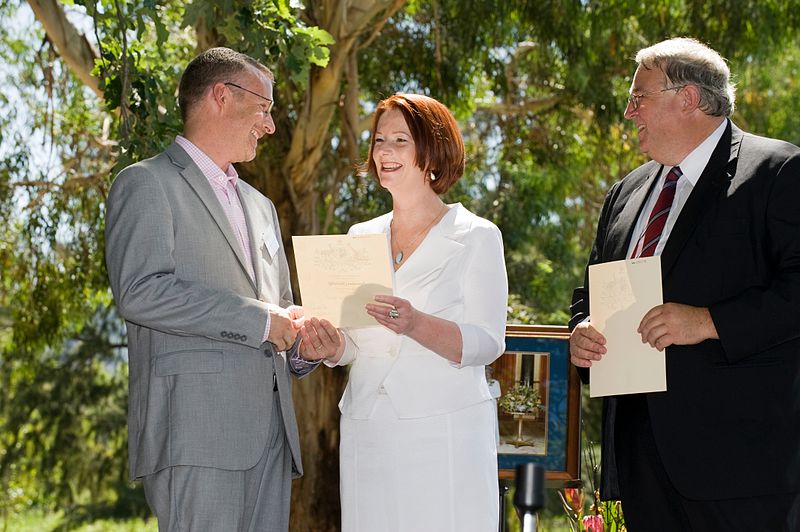Julia Gillard, Australia’s Prime Minister for the last three years and first woman to hold the position, has been ousted by her own party. During Gillard’s tenure, her gender became a focus, including a spotlight on how she dressed and looked.

Julia Gillard as Prime Minister in 2011. Should she really have been wearing white at this citizenship event on Australia Day? And look at that collar! Is the skirt too tight? And less than long sleeves? – – – good thing she is not in Tennessee.
[image of Gillard on Australia Day 2011 via]
This fixation on the attire and appearance of female leaders, including Gillard, was expertly discussed last week by the redoutable and brilliant Anne Summers:
Although male politicians might occasionally have some aspect of their clothes remarked upon—Paul Keating [former Austrailan PM] was criticised for wearing Italian, rather than Australian-made, suits—they never, repeat never, have to endure the banality of the endless sartorial commentary that all women in politics, but especially the leaders, have to deal with. Women leaders need to adopt strategies to try to neutralise this. Hillary Clinton, when she was running for president in 2008 and later as US secretary of state, adopted the pants suit as a virtual uniform. She varied the colour and added accessories such as scarves or jewellery but essentially she, like men in public life, wore the same outfit every day. German Chancellor Angela Merkel has done the same. She has such an array of different coloured jackets, which she wears over black pants, that some wag even created a pictorial representation of a Pantone-style colour chart of her wearing them all and labelled it ‘Fifty Shades of Angela Merkel’. Gillard evidently struggled for a time to vanquish this issue. She has admitted how hard it was for her to face the daily criticism of what she was wearing. This was especially cruel and relentless in her first year in the job when her jackets, especially, were singled out as ill-fitting and badly designed. In April 2013 Gillard commented that she had since worked to make sure her clothes were not an issue. She now has a wardrobe of well-tailored outfits, mostly suits, in solid colours. Wearing them, she exudes the confidence that comes from knowing her ‘look’ is going to emphasise her overall purpose rather than undermine it.
Yet however hard Gillard and other women leaders work to defuse their appearance as a subject of commentary, they cannot escape it altogether.
Summers goes on to discuss the options exercised by other women leaders, including adopting “traditional female dress.” Summers is also worth reading on the consequences of Gillard’s departure.
And if you have never seen Gillard’s “misogyny speech” in Australia Parliament, it’s definitely worth watching. She wore blue.
